Quality Over Quantity
The Pottery of the Overbeck Sisters
by Bob Brooke
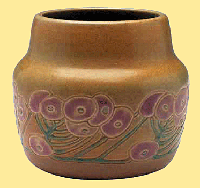 While
most people normally associate the Arts & Crafts Movement with such
names as Morris, Stickley, Roycroft, and Rookwood, few ever heard of
four sisters named Overbeck who, from their modest home studio in
Cambridge City, Indiana, created some of the finest studio pottery ever
to come out of Indiana. Their goal, “Quality over quantity.” While
most people normally associate the Arts & Crafts Movement with such
names as Morris, Stickley, Roycroft, and Rookwood, few ever heard of
four sisters named Overbeck who, from their modest home studio in
Cambridge City, Indiana, created some of the finest studio pottery ever
to come out of Indiana. Their goal, “Quality over quantity.”
From the beginning, the sisters' goal was to produce quality, not
quantity. The women learned by trial-and-error and their workshop was
simple, consisting of an electric potter's mill, a portable kiln fueled
with coal oil, and a clay-sifter made by a handyman. They believed in
two principles—that all borrowed art is dead art and its corollary, that
all good applied design is original. As part of the Arts & Crafts
Movement, the Overbecks often looked to plants, trees, birds, and
animals for their design motifs. And that quality goal is the reason
there aren’t many of their works out there.
So who
were the Overbecks?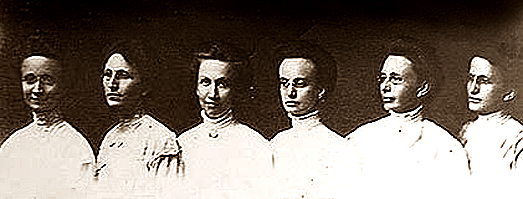
Though the sisters grew up in a farming family, the arts filled their
home. Their father was a cabinetmaker and their mother knitted, stitched
quilts, weaved rugs, and sewed lace. All four sisters taught art at some
point, and all but Elizabeth worked in other media, producing oil
paintings, watercolors, pastels, and black-and-white drawings. They also
produced tie-dye fabrics, executed enamel on copper, decorated
porcelain, and even made earrings, pins, and buckles. The pottery studio
always included baskets of crochet, knitting projects, and delicate
lacework.
Margaret
As the guiding spirit for the Overbeck Pottery, Margaret, the eldest
sister, studied at the Cincinnati Art Academy from 1892 to 1893 under J.
H. Sharp, L. H. Meakin, Lewis Cass Lutz, Vincent Nowattny, and Otto W.
Beck as well as from Arthur Wesley Dow and Marshall Fry of Columbia
University. She taught at the Sayre Institute in Lexington, Kentucky and
at the Megguier Seminary in Boonville, Missouri. She also gave early art
instruction to her younger sisters, Hannah and Mary Frances, before they
attended art schools. From 1899 to 1911, Margaret taught drawing,
watercolor and china painting at DePauw University in Greencastle,
Indiana. Sadly, she suffered severe head injuries from an automobile
accident in Chicago in August of 1907. While home recovering, she
organized and taught classes in Richmond, just 15 miles away. Three
years later she worked as a decorator at the Zanesville Art Pottery and
returned home to Cambridge City after the pottery factory burned.
Hannah
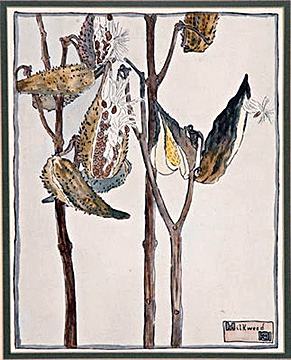 Sister
Hannah attended Cincinnati Art Academy and Indiana State University and
became a perfectionist in sketching and water colors. Ceramic Studio, a
magazine for china painters, featured her drawings. She, too, taught art
classes before returning home in poor health. Though bed-ridden with
severe neuritis, she continued to design by having the pencil placed in
her fingers. Sister
Hannah attended Cincinnati Art Academy and Indiana State University and
became a perfectionist in sketching and water colors. Ceramic Studio, a
magazine for china painters, featured her drawings. She, too, taught art
classes before returning home in poor health. Though bed-ridden with
severe neuritis, she continued to design by having the pencil placed in
her fingers.
Elizabeth
Elizabeth, the potter of the group, studied with Margaret in her early
years and later at the College for Ceramics in New York with noted
ceramist, Professor Charles Binns. As a teacher and lecturer, Elizabeth
exhibited widely, bringing much honor and recognition to the Overbeck
Pottery. Listed in the American Arts Annual and Who's Who in American
Art, she received the highest honor for ceramists, being named a Fellow
in the American Ceramic Society.
Mary
Frances
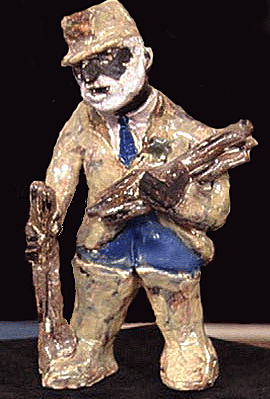 Her
sister, Mary Frances, attended the Cincinnati Art Academy, Indiana State
University and Columbia University. She taught for a time before joining
her sisters at the Pottery. A talented designer, Mary excelled in a wide
range of art, selling original bookplates, sculpted, and painted in oils
and water colors in addition to the vases, pottery and figurines. She
was listed in American Arts Annual as well as Who's Who in American Art. Her
sister, Mary Frances, attended the Cincinnati Art Academy, Indiana State
University and Columbia University. She taught for a time before joining
her sisters at the Pottery. A talented designer, Mary excelled in a wide
range of art, selling original bookplates, sculpted, and painted in oils
and water colors in addition to the vases, pottery and figurines. She
was listed in American Arts Annual as well as Who's Who in American Art.
Unfortunately, Margaret would never see the family pottery develop as
she died in August 1911, as a result of her injuries from the automobile
accident in 1907
The Overbecks threw pots in the basement, decorated them in the first
floor workroom, fired them in a shed in the yard, and sold them at the
dining room table.
Margaret had her first design for china painting, a popular pastime for
women, published in Keramic Studio magazine in June 1903. Hannah and
Mary Francis also had designs published first in 1904, and all of them
contributed regularly to Keramic until 1916.
Regular exhibits within the state and major exhibits outside the state,
including the Panama-Pacific International Exhibition, San Francisco, in
1915 and the 1933 Century of Progress Exhibition in Chicago, brought
acclaim to the Overbecks and visitors to their pottery.
The Work
of the Overbecks
The majority of the Overbecks’ work included painted porcelain, red
ware, imported vases, and figurines modeled on real-life persons or
"grotesques" which Mary called "humor of the kiln." They were especially
noted for their subtle hues in matte glazes as well as brilliant
turquoise and heliotrope in bright glazes.
Each sister took on specialties in their collaborative endeavor. Hannah
and Mary Francis designed most of the pots. Elizabeth experimented with
glazes and clays.
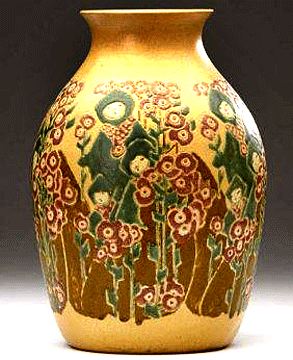 The
Overbecks usually made functional pieces, such as teapots, pitchers and
tea sets, and preferred simple shapes. Their early works reflected the
Art Nouveau style. The Arts & Crafts style influenced the majority of
their works, and their later works reflected the Art Deco style. They
had no production lines to maximize sales. Each piece was unique and
their output was modest. Only Elizabeth used the potter’s wheel. Hannah
and Mary Francis made all of their pieces by hand. They experimented
with their own glazes—they often used matt glazes and soft tones,
although a robin's-egg blue became a trademark—and they kept the
formulas for their glazes secret. All their pieces feature delicate,
intricate designs, using subtle colors that are close to each other in
tone. If a piece came out differently than they planned, they destroyed
it. The
Overbecks usually made functional pieces, such as teapots, pitchers and
tea sets, and preferred simple shapes. Their early works reflected the
Art Nouveau style. The Arts & Crafts style influenced the majority of
their works, and their later works reflected the Art Deco style. They
had no production lines to maximize sales. Each piece was unique and
their output was modest. Only Elizabeth used the potter’s wheel. Hannah
and Mary Francis made all of their pieces by hand. They experimented
with their own glazes—they often used matt glazes and soft tones,
although a robin's-egg blue became a trademark—and they kept the
formulas for their glazes secret. All their pieces feature delicate,
intricate designs, using subtle colors that are close to each other in
tone. If a piece came out differently than they planned, they destroyed
it.
Mary Frances and Hanna traced meticulous designs onto their pieces, then
incised, decorated and glazed them. No two pieces were alike, although
they often reused portions of a design.
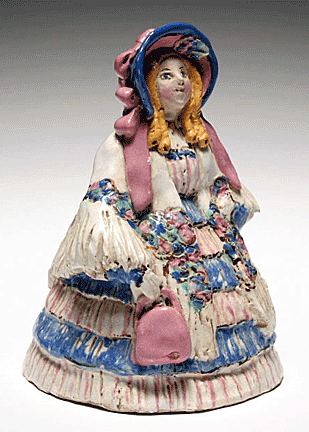 Hannah
died in 1931, and then Elizabeth in 1936. Mary Frances continued to
operate the pottery alone until her death in 1955, producing mainly
flgurines. They included charming Southern Belles townspeople and
animals, historical figures, and grotesques, originally made to use up
clay and leftover glazes. It was nothing for her to make a mauve and
blue elephant or a multi-hued bird sitting on a branch. Hannah
died in 1931, and then Elizabeth in 1936. Mary Frances continued to
operate the pottery alone until her death in 1955, producing mainly
flgurines. They included charming Southern Belles townspeople and
animals, historical figures, and grotesques, originally made to use up
clay and leftover glazes. It was nothing for her to make a mauve and
blue elephant or a multi-hued bird sitting on a branch.
Overbeck pieces start at around $300 for one of their grotesque
figurines. The Southern Belle, for instance, sells for $200 to $400. A
top Overbeck piece could bring $75,000 to $100,000 in a rare case. But
vases generally sell for $25,000 to $50,000 each.
The quality of the Overbeck vases is exceptional. But their fame came
from their quirky, small-studio, weird pursuit of creating beautiful,
original, and personal art pottery. That was a very romantic Arts &
Crafts idea.
To read
more of my articles, please
visit
my Web site.
<
Back to Collectibles Archives
Next Article > |
